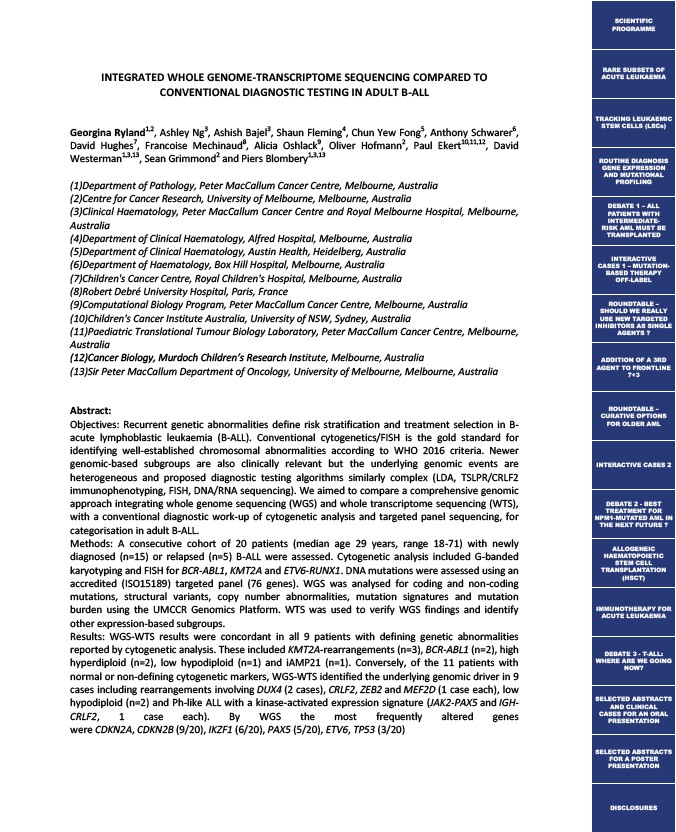
INTEGRATED WHOLE GENOME-TRANSCRIPTOME SEQUENCING COMPARED TO
CONVENTIONAL DIAGNOSTIC TESTING IN ADULT B-ALL
Georgina Ryland1,2, Ashley Ng3, Ashish Bajel3, Shaun Fleming4, Chun Yew Fong5, Anthony Schwarer6,
David Hughes7, Francoise Mechinaud8, Alicia Oshlack9, Oliver Hofmann2, Paul Ekert10,11,12, David
Westerman1,3,13, Sean Grimmond2 and Piers Blombery1,3,13
(1)Department of Pathology, Peter MacCallum Cancer Centre, Melbourne, Australia
(2)Centre for Cancer Research, University of Melbourne, Melbourne, Australia
(3)Clinical Haematology, Peter MacCallum Cancer Centre and Royal Melbourne Hospital, Melbourne,
Australia
(4)Department of Clinical Haematology, Alfred Hospital, Melbourne, Australia
(5)Department of Clinical Haematology, Austin Health, Heidelberg, Australia
(6)Department of Haematology, Box Hill Hospital, Melbourne, Australia
(7)Children's Cancer Centre, Royal Children's Hospital, Melbourne, Australia
(8)Robert Debré University Hospital, Paris, France
(9)Computational Biology Program, Peter MacCallum Cancer Centre, Melbourne, Australia
(10)Children's Cancer Institute Australia, University of NSW, Sydney, Australia
(11)Paediatric Translational Tumour Biology Laboratory, Peter MacCallum Cancer Centre, Melbourne,
Australia
(12)Cancer Biology, Murdoch Children’s Research Institute, Melbourne, Australia
(13)Sir Peter MacCallum Department of Oncology, University of Melbourne, Melbourne, Australia
Abstract:
Objectives: Recurrent genetic abnormalities define risk stratification and treatment selection in B-acute
lymphoblastic leukaemia (B-ALL). Conventional cytogenetics/FISH is the gold standard for
identifying well-established chromosomal abnormalities according to WHO 2016 criteria. Newer
genomic-based subgroups are also clinically relevant but the underlying genomic events are
heterogeneous and proposed diagnostic testing algorithms similarly complex (LDA, TSLPR/CRLF2
immunophenotyping, FISH, DNA/RNA sequencing). We aimed to compare a comprehensive genomic
approach integrating whole genome sequencing (WGS) and whole transcriptome sequencing (WTS),
with a conventional diagnostic work-up of cytogenetic analysis and targeted panel sequencing, for
categorisation in adult B-ALL.
Methods: A consecutive cohort of 20 patients (median age 29 years, range 18-71) with newly
diagnosed (n=15) or relapsed (n=5) B-ALL were assessed. Cytogenetic analysis included G-banded
karyotyping and FISH for BCR-ABL1, KMT2A and ETV6-RUNX1. DNA mutations were assessed using an
accredited (ISO15189) targeted panel (76 genes). WGS was analysed for coding and non-coding
mutations, structural variants, copy number abnormalities, mutation signatures and mutation
burden using the UMCCR Genomics Platform. WTS was used to verify WGS findings and identify
other expression-based subgroups.
Results: WGS-WTS results were concordant in all 9 patients with defining genetic abnormalities
reported by cytogenetic analysis. These included KMT2A-rearrangements (n=3), BCR-ABL1 (n=2), high
hyperdiploid (n=2), low hypodiploid (n=1) and iAMP21 (n=1). Conversely, of the 11 patients with
normal or non-defining cytogenetic markers, WGS-WTS identified the underlying genomic driver in 9
cases including rearrangements involving DUX4 (2 cases), CRLF2, ZEB2 and MEF2D (1 case each), low
hypodiploid (n=2) and Ph-like ALL with a kinase-activated expression signature (JAK2-PAX5 and IGH-CRLF2,
1 case each). By WGS the most frequently altered genes
were CDKN2A, CDKN2B (9/20), IKZF1 (6/20), PAX5 (5/20), ETV6, TP53 (3/20)
SCIENTIFIC
PROGRAMME
RARE SUBSETS OF
ACUTE LEUKAEMIA
TRACKING LEUKAEMIC
STEM CELLS (LSCs)
ROUTINE DIAGNOSIS
GENE EXPRESSION
AND MUTATIONAL
PROFILING
DEBATE 1 – ALL
PATIENTS WITH
INTERMEDIATE-RISK
AML MUST BE
TRANSPLANTED
INTERACTIVE
CASES 1 – MUTATION-BASED
THERAPY
OFF-LABEL
ROUNDTABLE –
SHOULD WE REALLY
USE NEW TARGETED
INHIBITORS AS SINGLE
AGENTS ?
ADDITION OF A 3RD
AGENT TO FRONTLINE
7+3
ROUNDTABLE –
CURATIVE OPTIONS
FOR OLDER AML
INTERACTIVE CASES 2
DEBATE 2 - BEST
TREATMENT FOR
NPM1-MUTATED AML IN
THE NEXT FUTURE ?
ALLOGENEIC
HAEMATOPOIETIC
STEM CELL
TRANSPLANTATION
(HSCT)
IMMUNOTHERAPY FOR
ACUTE LEUKAEMIA
DEBATE 3 - T-ALL:
WHERE ARE WE GOING
NOW?
SELECTED ABSTRACTS
AND CLINICAL
CASES FOR AN ORAL
PRESENTATION
SELECTED ABSTRACTS
FOR A POSTER
PRESENTATION
DISCLOSURES